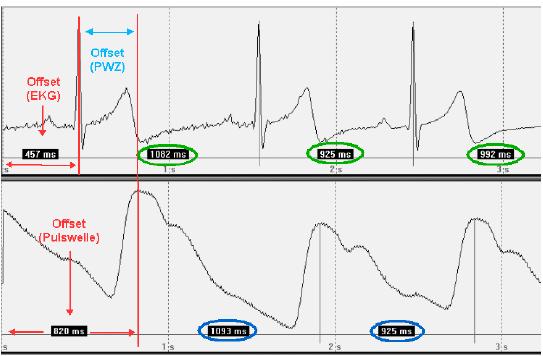Frequently Asked Questions
- Q: Piechulla is an odd name, where does it come from?
- Q: How many subjects were in the pilot study?
- Q: Exponential decay function?
- Q: Exponential decay: I am not sure how it all fits together!
- Q: Should I use your Analyse.exe for ecg analysis?
- Q: What else can Analyse.exe do?
- References
- To be continued next weekend
Q: Piechulla is an odd name, where does it come from?
A: This seems to be an inevitable question. Especially native speakers of German often try to figure out (in vain) how to pronounce Piechulla 'correctly'. I don't care at all! Piechulla is a Polish name (and I don't speak Polish). Piechulla means son/relative of Piech. The first name Piech is derived from the slavic first name Pietr. Pietr either derives from Petrus (Greek the rock) or Pielgrzym (Latin Peregrinus stranger/pilgrim). Piechulla is a rare name. There are approximately 20 persons with this name in Poland and about 280 in Germany. One of them kindly made available an expert's report about the name (crazy but true): Gutachten zu dem Familiennamen Piechulla.
Q: How many subjects were in the pilot study?
A: Only three taxi drivers, unfortunately. I intended to use more subjects. But when I was finished with the quite tedious data analysis of these three subjects (each driver made three rides, this gives the 'nine journeys' mentioned in the TRF article p 237) I already had to move on to the next step of the project. I was a freelancer at the time. Would you dare to suggest something very slow and expensive in this situation? Resources were tight...
Q: Exponential decay function?
A: I saw that the road look-ahead provided by the map tracker could be extreme (up to kilometers!). But obviously, a driver does not bother what comes -- let's say 1 km ahead. So, you must cut off the look-ahead. But where and how? The literature provided not much cues, except the 300 m hint (Hawkins, 1988) and the 4 s guess (Verwey, 2000) discussed in my TRF article. I ended up having people draw sketches about their imaginations of a 'good weighting' on a piece of paper. I simlpy fed this into a modelling software and it spit out this exponential first order decay.
Q: Exponential decay: I am not sure how it all fits together!
A: This is how it's done:
double dStrainSum = 0.;
double dSumOfWeights = 0.;
double dDistanceWeight = 0.;
// from 1st look ahead point to end of Fahrschlauch
for (int i = 0; i < METASEQUENCE_LENGTH; i++)
{
dDistanceWeight = GetDistanceWeight(Mp[i].dReachedInSec);
dStrainSum += Mp[i].dStrain * dDistanceWeight;
dSumOfWeights += dDistanceWeight;
}
double dStrainEstimate = dStrainSum / dSumOfWeights;
// 5 seconds with weight 1.0 (following Verwey 2000), then exponential decay
double GetDistanceWeight(double timeAhead)
{
const double A = 2.71866;
const double t = 4.72657;
double retVal = 1.;
if (timeAhead > 5.)
{
retVal = A * exp(-timeAhead/t);
}
return retVal;
}
Feel free to ask if there are still questions.
Q: Should I use your Analyse.exe for ecg analysis?
A: There are a lot of commercial analysis packages, and some free tools. In my humble opinion, the most authoritative work done in the open-source realm is George Moody's.
I do not advocate usage of Analyse.exe. I never saw it as a 'product'. I just needed this tool for my work at Regensburg University in 2002. I wrote it because the tools I had access to were very cumbersome and somewhat obscure. Since I was paid by the University, I felt I had to meet the obligation to reveal my source codes. Warning: these codes are ugly, because they were written very quickly.
Be sure to check the quality of R-spike detection if you insist in using my tool. Fig. 1 shows bad raw data sent by a user. The data in Fig. 2 (sent by another user) are ok. Fig. 3 is a data snippet from the SANTOS tests, recorded with a Varioport recorder.

Fig. 1: Bad raw data

Fig. 2: Good raw data

Fig. 3: Varioport raw data
Q: What else can Analyse.exe do?
One user abused it for ear-pulse data in his diploma thesis (Fig. 4, lower panel). Didn't know that this works.

Fig. 4: Unexpected usage (courtesy of EADS Militärflugzeuge)
References
Hawkins, R. K. (1988). Motorway traffic behaviour in reduced visibility conditions. In A. G. Gale (Ed.), Vision in vehicles II (pp. 9–18). Amsterdam: Elsevier.
Verwey, W. B. (2000). On-line driver workload estimation. Effects of road situation and age on secondary task measures. Ergonomics, 43, 187–209
To be continued next weekend
A lot of questions I answered are still buried on my hard disk...




